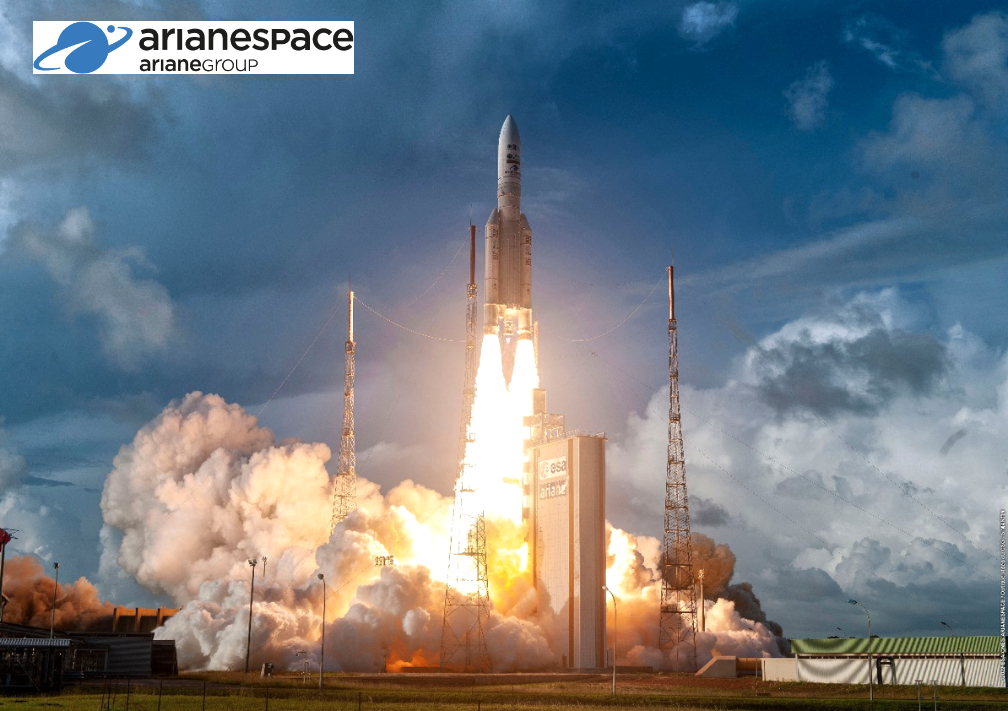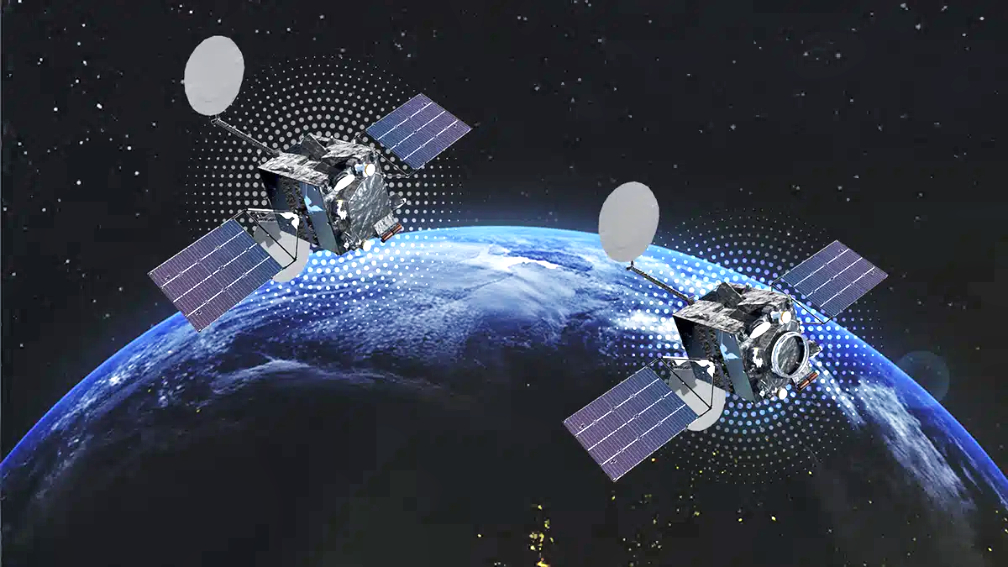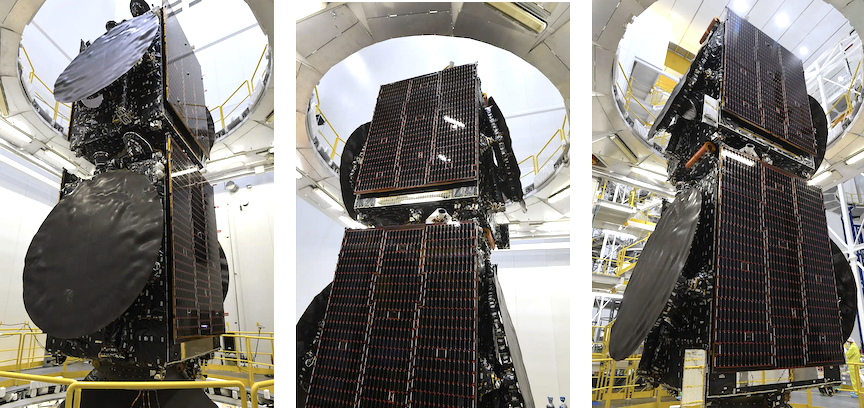
On Tuesday, December 13th, 2022, at 5:30 p.m. local time, an Ariane 5 launcher, operated by Arianespace, successfully lifted off from Europe’s Spaceport in Kourou, French Guiana (South America), carrying the MTG-I1 meteorological satellite and the Galaxy 35 and Galaxy 36 telecommunication satellites.

The Meteosat Third Generation (MTG) system will help meteorologists meet one of their main challenges – the rapid detection and forecasting of severe weather events — so that timely warnings can be given to citizens, civil authorities and first responders.
The data from MTG-I1 (the “I” stands for “Imager”) will have a wide range of uses, from enabling aircraft to avoid storms and earlier alerts of flooding, to more precise monitoring of fires and fog. It will help to protect lives, property and infrastructure and bring economic benefits to Europe and Africa.
The MTG satellites are developed and procured in cooperation with the European Space Agency by an industrial consortium led by Thales Alenia Space and OHB. The satellites are developed according to the requirements defined by EUMETSAT after consultation with the users of its meteorological data.
Galaxy 35 and Galaxy 36 are the next satellites in Intelsat’s comprehensive Galaxy fleet refresh plan, a new generation of spacecraft that will provide Intelsat media customers in North America with high-performance media distribution capabilities and unmatched penetration of cable headends.

These two satellites will bring C-band contribution capacity to support high-profile events, such as collegiate and professional football, auto racing, baseball, golf, boxing and professional wrestling. The satellites also offer in-orbit protection for select customers in the broadcast arc serving North America.
By delivering 10.972 tons to geostationary orbit, Ariane 5 achieved its second highest performance after the launch of Syracuse A4 and SES-17 in October 2021. The Ariane 5 was adapted for this mission so that it could accommodate three satellites under its fairing. This triple configuration is made possible by a raising cylinder and a long fairing, increasing the space allocated to the satellites by 20m3. This is the third time in its history that Ariane 5 has done a triple launch.
After this mission, just two Ariane 5 launches are left, including the JUICE mission, before Ariane 6 takes up the baton, supporting Europe’s institutional missions and meeting the growing needs of the commercial market.
The Ariane 5 heavy-lift launcher is an ESA program carried out in cooperation between public institutions and industry across 12 European partner states. The launches are operated by Arianespace.
“With the successful launch of VA259, Arianespace is proud to serve the interests of EUMETSAT and Intelsat, two operators with whom we have been working since 1981 and 1983, respectively”, said Stéphane Israël, CEO of Arianespace. “This mission serves both Europe and North America and is a perfect illustration of the versatility of our heavy-lift launcher, which is capable of meeting the needs of both institutional and commercial operators. Its passengers also reflect our own values, which are to make Space work for a better life on Earth, by improving our meteorological knowledge and connectivity.”
“For its last flight of the year, Ariane 5 once again demonstrated its power and competitiveness, achieving a new performance of almost 11 tons to geostationary orbit. It also proved its responsiveness to the needs of Arianespace’s customers, by launching three satellites at once. Only two more Ariane 5 remain to be launched. The teams at ArianeGroup and Arianespace, with the support of ESA and the French space agency CNES, are preparing together for Ariane 6’s entry into service in autumn 2023”, said André-Hubert Roussel, CEO of ArianeGroup.
ArianeGroup is the lead contractor for the development and production of Ariane 5, as well as being responsible for launcher preparation operations up to lift-off. As prime contractor for Ariane 5 and Ariane 6, in charge of development and production, ArianeGroup is at the head of a vast industrial network of more than 600 companies, including 350 small and medium-size enterprises (SME). ArianeGroup delivers a flightworthy launcher on the launch pad to its subsidiary Arianespace, which sells and operates Ariane 5 from the Guiana Space Center (CSG) in French Guiana. During launch campaigns, Arianespace works closely with the French space agency (CNES), which is the design authority for Ariane 5 and is responsible for the satellite preparation facilities and the launch base.
Original info posting…
On Tuesday, December 13, 2022 at 5:30 p.m. local time (8:30 p.m. UTC), Arianespace’s next Ariane 5 mission will lift off from Europe’s Spaceport, French Guiana, with MTG-I1 meteorological satellite and Galaxy 35 and Galaxy 36 telecommunications satellites. The mission duration will be 34 minutes and 37 seconds.

The satellites will be launched for two major companies and long-standing Arianespace customers: the European Organization for the Exploitation of Meteorological Satellites EUMETSAT and the multinational satellite services and communication provider Intelsat.
The MTG system is the most complex and innovative geostationary meteorological satellite system ever built. When fully deployed, European meteorologists will be able, for the first time, to monitor the full life cycle of storms — from initial instability in the atmosphere through to lightning strikes. MTG-I1 will produce images of Europe and Africa every 10 minutes from the Flexible Combined Imager’s 16 spectral channels. The Lightning Imager will continuously map lightning flashes between clouds and from clouds to the ground. Higher resolution imagery will be available more quickly, in a significant advance for forecasting of rapidly developing severe weather events.
The Meteosat Third Generation (MTG) system will help meteorologists meet one of their main challenges – the rapid detection and forecasting of severe weather events — so that timely warnings can be given to citizens, civil authorities and first responders. The data from MTG-I1 (I stands for Imager) will have a wide range of uses, from enabling aircraft to avoid storms and for earlier alerts of flooding, through to more precise monitoring of fires and fog. It will help to protect lives, property and infrastructure and bring economic benefits to Europe and Africa.

The MTG satellites are developed and procured in cooperation with the European Space Agency by an industrial consortium led by Thales Alenia Space in cooperation with OHB. The satellites are developed according to the requirements defined by EUMETSAT after consultation with the users of its meteorological data.
Galaxy 35 and Galaxy 36 are the next satellites in Intelsat’s comprehensive Galaxy fleet refresh plan, a new generation of spacecraft that will provide Intelsat Media customers in North America with high-performance media distribution capabilities and unmatched penetration of cable headends. These two satellites will bring C-band contribution capacity to support high-profile events, such as collegiate and professional football, auto racing, baseball, golf, boxing and professional wrestling. The satellites also offer in-orbit protection for select customers in the broadcast arc serving North America.

Galaxy 35 and Galaxy 36 are geosynchronous communications satellites that will provide dedicated North American links to broadcasters allowing them to air live events and programs including sports, entertainment and breaking news coverage. Additionally, the satellites also offer in-orbit protection for select customers in the broadcast arc serving North America.
Galaxy 35 will replace Galaxy 3C and Galaxy 36 will replace Galaxy 28.
Today’s launch continues Intelsat’s Galaxy fleet refresh plan that started with Galaxy 30 in 2020 and carries the fifth and sixth out of seven new Intelsat satellites launching in the coming months.
The launch at a glance: 343rd launch for the Arianespace launcher family (306th launch from CSG).Galaxy 35, Galaxy 36 and MTG-I1 will be the 1146th, 1147th and 1148thsatellites launched by Arianespace. 115th launch of Ariane 5 overall.
